MXA’S 2014 KTM 150SX MOTOCROSS TEST: THIS BIKE IS DESIGNED TO BE RIDDEN BY A SPECIAL KIND OF RIDER
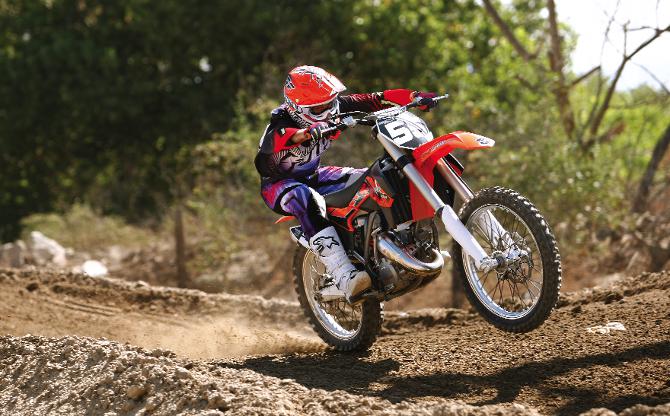
Q: FIRST AND FOREMOST, IS THE 2014 KTM 150SX BETTER THAN THE 2013 KTM 150SX?
A: The easy answer is no. Most of the changes that KTM made to the 2014 150SX either didn’t bring about significant improvement or were pushes at best.
Q: WHAT CHANGES DID KTM MAKE TO THE 2014 150SX ENGINE?
A: There were only three changes to the 150 powerplant for 2014.
(1) Jetting. After years of on-the-edge jetting, KTM fiddled with the brass one more time.
(2) Black box. The ignition mapping has less advance off the bottom but returns to the same advance as in 2013 once the power valve opens.
(3) Reeds. After a couple years of using Moto Tassinari VForce reeds, KTM switched to Boyesen RC2 performance-weave carbon fiber reed petals housed in a KTM-designed reed block. The reed block mimics the VForce with its twin Vs and eight petals.
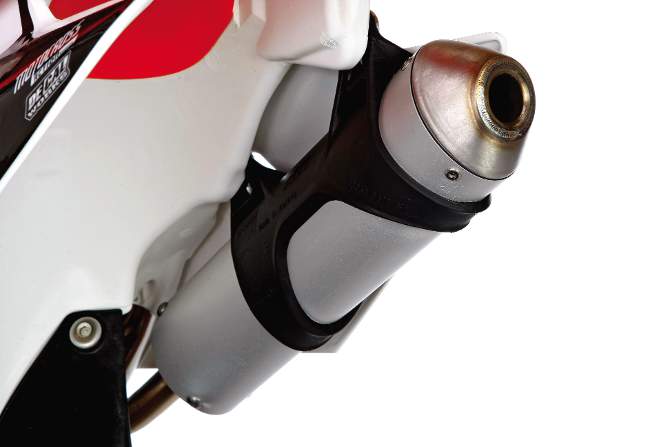
Q: WHAT ELSE WAS NEW ON THE 2014 KTM 150SX TWO-STROKE?
A: The following upgrades weren’t model-specific but rather brand-specific updates. Model-specific changes are ones that are introduced only on one model, like the KTM 150SX’s jetting changes, while brand-specific mods are done to every bike in the company’s lineup.
(1) Swingarm. KTM lightened the chain guide by 120 grams and beefed up its swingarm brackets.
(2) Front brake. The front master cylinder has a new reservoir, reshaped lever and a smaller piston diameter (down from 10mm to 9mm). The brake-pad material has also been changed. It should be noted that the 125SX and 150SX use Magura hydraulic clutches, while the rest of the KTM line uses Brembo clutches.
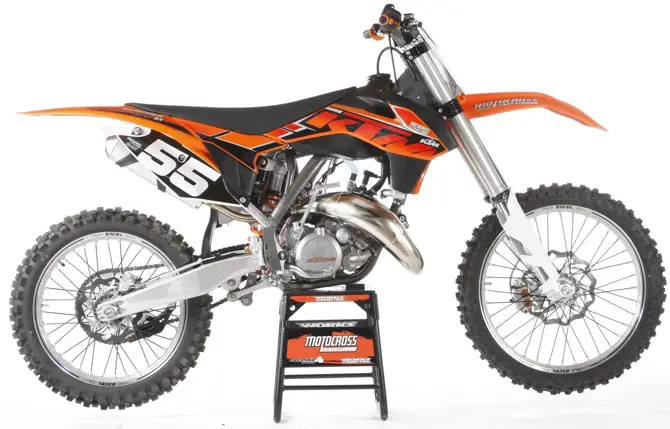
(3) Seat foam. The foam core of the saddle has been reformulated to be softer initially but not break down as quickly.
(4) Gas cap. The internal threads on the gas cap have been reworked for more positive engagement, and the gas cap has a new low-profile shape; it doesn’t stick up as high as last year’s cap.
(5) Plastic. For 2014, the graphics on the shrouds, airbox cover and side winglet are permanent in-mold decals.

Q: WHAT’S THE DIFFERENCE BETWEEN A 125SX AND A 150SX?
A: Both the KTM 125SX and 150SX share the same basic suspension, frame geometry, shock linkages, brakes, wheels and overall design, but they aren’t identical.
Displacement. The 150SX is 143.6cc. The 125SX is 124.8cc.
Bore and stroke. The 150SX’s bore and stroke is 56mm by 58.4mm, while the 125SX’s is 54mm by 54.5mm.
Gearing. More power can pull taller gearing, thus the 150SX comes with 13/48 gearing, while the 125SX gets 13/50.
Parts. The 125SX’s and the 150SX’s crankshafts, cylinders, pistons, power valves and rings are different.
Clutch. The 150SX uses all-steel drive plates, while the 125SX uses aluminum drive plates, except for two steel plates in the middle of the clutch pack. The 150 also has stiffer clutch springs.
Jetting. Last year, the 125SX and 150 shared the same jetting specs. This year, the mainjet, pilot, needle and clip position are all different.
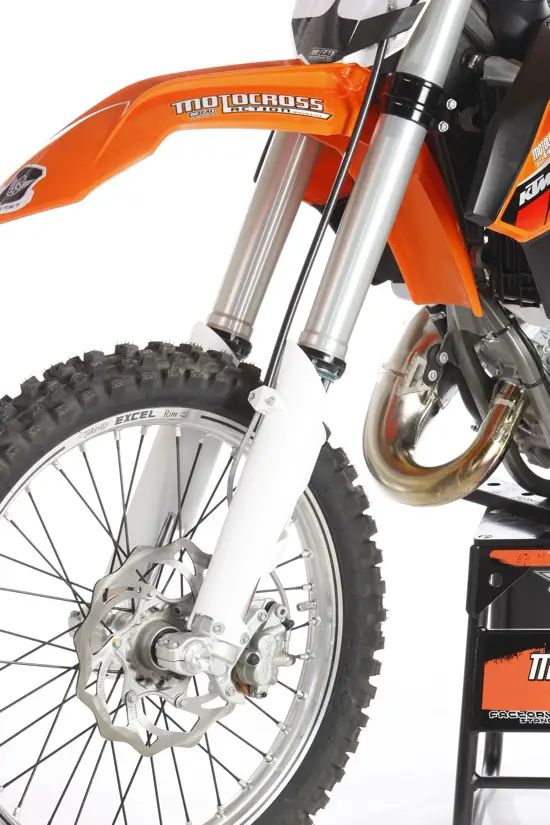
Q: HOW FAST IS THE 2014 KTM 150SX?
A: Many modern motocross bikes are fast in spite of their riders’ ham-fisted riding. You can just sit on them, twist the throttle and run out of talent before you run out of speed. Not so with a 2014 KTM 150SX. It only goes fast if you ride it fast. If you sit on a 150SX like a lump of coal and expect it to turn you into a diamond, you will have a long wait.
Unlike with a four-stroke, you have to generate speed from a two-stroke by riding like a spree-killer. Turn it on, never shut it off, reload fast and take no prisoners. If both hands aren’t moving as fast as Liberace’s on the keyboard and you aren’t moving your body like a soap opera actress on “Dancing With the Stars,” you aren’t riding it right.
Here’s a clue. If you can’t hear the engine screaming, you aren’t going fast. It takes an all-out commitment to race a 150SX. That means that it’s not the proper weapon for the old, fat, lazy, uncoordinated, timid or maladroit. It is not an axe that you swing blindly; it is a scalpel.
Only one out of every 10 (maybe one out of every 100) riders is cut out to race a small-bore two-stroke. Let’s agree right now that if you aren’t a little crazy, you aren’t KTM 150SX material.

Feather: At 206 pounds, the 2014 KTM 150SX feels like a feather compared to the heft of a 224-pound 250 four-stroke.
Q: HOW DOES THE 2014 KTM 150SX RUN ON THE DYNO?
A: Not surprisingly, it runs identical to the 2013 model, because neither of the engine mods changed the output. Peak horsepower was 38.81 horsepower at 11,100 rpm on not just the 2014, but the 2013 and 2012 models as well.
Q: HOW DOES THE 2014 KTM 150SX COMPARE TO THE 125SX ON THE DYNO?
A: It is a blow out. At no point on the dyno curve did the 125SX come within 3 horsepower of the KTM 150SX. Whereas the 150SX peaked at 38.81 horsepower, the 125SX peaked at 34.66. This power difference, specifically the four extra horses from 9000 rpm to 11,000 rpm, is obvious on the track.

2014 KTM 150SX: When KTM makes an improvement on one model, they share those changes with the other models. Thus, the 2014 KTM?150SX receives the four-stroke’s swingarm, seat, brake, gas cap and plastic updates, plus its own reed, mapping and jetting mods.
Q: WHAT IS THE EASIEST WAY TO MAKE THE 150SX BETTER?

Goose: Carbon fiber Boyesen reed petals are new for 2014.
A: Here is our 150SX wish list:
(1) Gearing. Since the 125SX is geared too tall at 13/50, the 150SX is no better at 13/48. Every MXA test rider selected a 49-tooth rear sprocket. Some switched to a 13/50.
(2) Aftermarket exhaust. You aren’t going to make much more than 38.81 horsepower at peak, but an aftermarket pipe from Pro Circuit or FMF can broaden the power, improve throttle response and increase over-rev.
(3) Shock linkage. Every MXA test rider chooses to run a 1.25mm-longer Pro Circuit link. It lowers the rear of the bike, which pays handling dividends, because with the lower rear, you can slide the forks up in the clamps to lower the whole chassis. Although it doesn’t change the rising rate, it changes the starting point of the rising rate.
(4) Gas-cap vent hose. KTM’s vent hose gets twisted in a knot when removing it. We drill a hole in the fork steering-stem cap to slip the vent hose into it. Now the vent hose can spin with the gas cap.
(5) Sprocket bolts. Watch them like a hawk.
(6) Fuel. Thanks to its new jetting, the 2014 KTM 150SX runs well on 91-octane pump gas, but we always added a dash of C12 as a precaution.
Q: WHAT DID WE HATE?

Boost: The KTM 150SX makes almost 39 horsepower.
A: The hate list:
(1) Preload ring. We don’t get it. Preload rings should be made of the hardest metal known to man, not gummy-bear nylon.
(2) Rims. Watch the spokes like a hawk or you will be flying like one. The telltale clue is the spoke next to the rear rim lock. If it’s loose, the wheel is on the edge.
(3) Gearing. Welcome to the Bonneville Salt Flats.
(4) Seat foam. It gets softer with every ride?and it isn’t all that firm to begin with.
(5) Forks. Maybe it is just us, but we don’t think that KTM is trying very hard to fix their greatest flaw.
Q: WHAT DID WE LIKE?
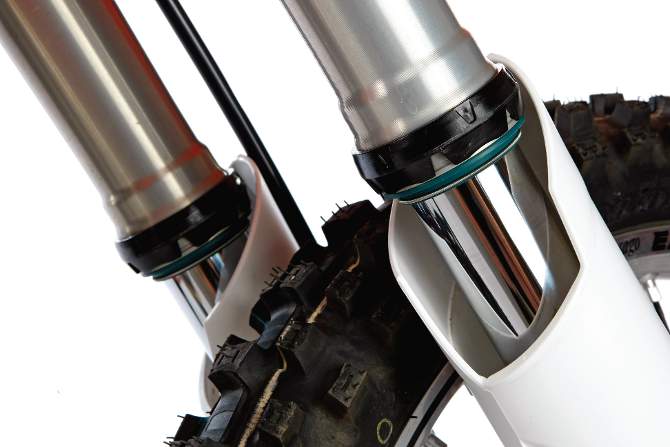
Seals: The stock green SKF fork seals are bulletproof.
A: The like list:
(1) Price. Two-stroke pricing will rise as the smokers get more popular, but right now they are much cheaper than anything with a camshaft. Prices are as follows: 125SX, $6499; 150SX, $6599; 250SX, $7199; 250SXF, $7999; 350SXF, $8799; and 450SXF, $8999. That makes the KTM 150SX $2500 cheaper than a 450SXF, $2300 cheaper than a 350SXF and $1500 cheaper than a 250SXF. You could fund a lot of racing fun with that dough.
(2) Weight. At 206.5 pounds, it is 18 pounds lighter than the typical 250 four-stroke.
(3) Brakes. When you use them, every orifice in your body puckers up.
(4) Hydraulic clutch. Psst. Hydraulic clutches must be new technology, because Honda, Yamaha, Suzuki and Kawasaki haven’t heard of them.
(5) Cosmetics. KTM’s unique plastic cladding design is attractive?and if you don’t think so, just wait; it will grow on you.
Q: WHAT DO WE REALLY THINK?
A: A 125cc two-stroke is a kid’s toy designed to bridge the gap between minicycles and a big bike. It is a great learning tool. A 150cc two-stroke is an adult toy designed to bridge the gap between grins and giggles. It is a great teaching tool. It teaches 450 riders to get out of the way.
MXA’S 2014 KTM 150SX SETUP SPECS
This is how we set up our KTM 150SX for racing. We offer it as a guide to help you find your own sweet spot.

WP FORK SETTINGS
We don’t like these forks?never have?and until they do something to them, we never will. The big change for 2014 is to switch from last year’s softer 0.42 N/mm fork springs to stiffer 0.44 N/mm springs. Since the KTM 150SX and KTM 125SX share the same valving, you would think that the 150SX’s damping would be on the soft side. Far from it. This bike has a very harsh feel on compression. Most MXA test riders prefer to lower the oil height by 10 to 20cc to try to improve the feel through the midstroke. Here’s what we ran in our 125SX and 150SX (the stock settings are in parentheses):
Spring rate: 0.44 N/mm
Compression: 6 clicks out (12 clicks out)
Rebound: 10 clicks out (12 clicks out)
Oil height: 350cc (360cc)
Fork-leg height: 5mm up
Notes: Since most of the 150SX’s fork issues are valving-related, we typically have the forks revalved by Pro Circuit, MX1 or MX-Tech.

WP SHOCK SETTINGS
There are no valving, linkage or spring-rate changes to the 2014 KTM 150SX model. Here is what we ran (stock settings are in parentheses):
Spring rate: 4.8 N/mm
Hi-compression: 2 turns out
Lo-compression: 15 clicks out (18 clicks out)
Rebound: 15 clicks out
Race sag: 100mm
Notes: Given that the 125SX and 150SX have the same suspension system as the 250SXF, 350SXF and 450SXF, and they run 5.4 to 5.7 kg/mm shock springs, you can see that the 150SX’s soft, 4.8 kg/mm shock spring is designed for riders in the 150-pound range. If you are heavier than that, you will need to go heavier on the shock spring.

KEIHIN PWK 38S JETTING SPECS
MXA has always felt that the 150SX runs lean, so lean that last year we upped the mainjet from the stock 182 to a richer 185. So, it strikes us as strange that KTM spec’ed a leaner 180 main jet for 2014. But since they switched from last year’s dual-taper NOZI needle to a richer, triple-taper N1EJ needle (and raised the needle one notch), they can get away with it. If it were us?and it is?we would keep a close eye on the jetting in cool weather or deep sand, because it could go lean with more oxygen in the air.
Here’s what we ran in our 38mm PWK (stock settings are in parentheses):
Mainjet: 180
Pilot: 40
Needle: N1EJ
Clip: 3rd clip from top
Air screw: 1-1/2 turns out
Notes: Listen carefully for pinging, as the KTM 150SX has historically pinged on low-grade fuel and in cold weather or deep sand.
SEE THE 2014 KTM 150SX IN ACTION…AND LISTEN TO IT SING




Comments are closed.